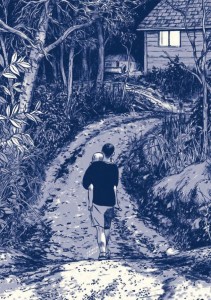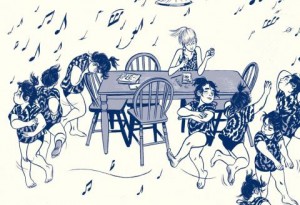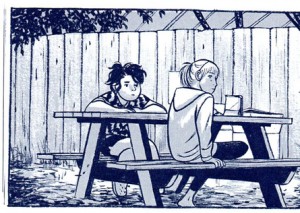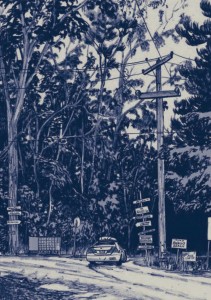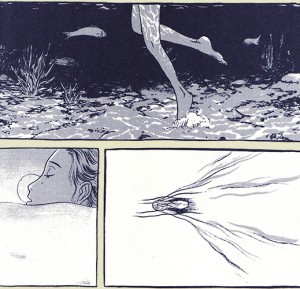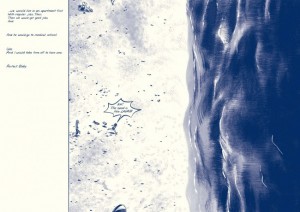Welcome to Using Graphic Novels in Education, an ongoing feature from CBLDF that is designed to allay confusion around the content of graphic novels and to help parents and teachers raise readers. In this column, we examine graphic novels, including those that have been targeted by censors, and provide teaching and discussion suggestions for the use of such books in classrooms.
 This past month, This One Summer (First Second, 2014) by Jillian Tamaki and Mariko Tamaki rocked the publishing, library, and literary world by being the first graphic novel to receive the Caldecott Honor for “Most Distinguished American Picture Book for Children” and the Printz Honor for “Excellence in Literature for Young Adults.” It has also been the subject of book challenges since receiving these honors. In this post, we examine This One Summer’s merits, issues of concern, and teaching elements to empower educators, parents, and librarians to make their own decisions (for ages 12+).
This past month, This One Summer (First Second, 2014) by Jillian Tamaki and Mariko Tamaki rocked the publishing, library, and literary world by being the first graphic novel to receive the Caldecott Honor for “Most Distinguished American Picture Book for Children” and the Printz Honor for “Excellence in Literature for Young Adults.” It has also been the subject of book challenges since receiving these honors. In this post, we examine This One Summer’s merits, issues of concern, and teaching elements to empower educators, parents, and librarians to make their own decisions (for ages 12+).
OVERVIEW
Told in warm prose and exquisite monochromatic blue images, This One Summer delicately balances the nostalgic power of summer traditions with the often harsh and intruding lessons of life. It embraces readers of all ages as two tween girls, local townie teens, and one set of parents all tangle in the delicate balances of friendships and relationships, grapple with the pains of growing up, deal with the torments of depression and of wanted and unwanted pregnancies, and cope with the heartbreaks and hopes of life. This One Summer has received outstanding praise and unprecedented honors for its stunning art and thoughtful, sensitive content.
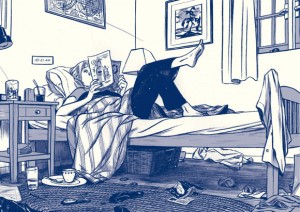 In This One Summer, the art is as powerful as the prose and they work brilliantly together, delicately weaving the troubles and traumas of Rose’s summer at Awago Beach. The beach’s bright summer days are mixed with endless wet heavy rain, both helping to sustain the luscious trees, vines, bushes, grass, milkweed, and verdant undergrowth of the surrounding woods. Then, there are illuminating summer night skies full of stars and striking moonlight. The details of the beach, the lake, the woods, and even Brewster’s convenience store are breathtaking and contrasted by the less-detailed characters. The story and art are richly relayed and juxtaposed, giving extraordinary depth and presence to the story and its true-to-life characters.
In This One Summer, the art is as powerful as the prose and they work brilliantly together, delicately weaving the troubles and traumas of Rose’s summer at Awago Beach. The beach’s bright summer days are mixed with endless wet heavy rain, both helping to sustain the luscious trees, vines, bushes, grass, milkweed, and verdant undergrowth of the surrounding woods. Then, there are illuminating summer night skies full of stars and striking moonlight. The details of the beach, the lake, the woods, and even Brewster’s convenience store are breathtaking and contrasted by the less-detailed characters. The story and art are richly relayed and juxtaposed, giving extraordinary depth and presence to the story and its true-to-life characters.
For example, Rose and Windy are often seen swimming, diving, splashing in the water, and readers wonder if they are literally and figuratively out of their depth. Alice, Rose’s mom, and Dunc, the store clerk Rose develops a crush on, are both drawn with strong angles reflecting their short straight hair (that they run their fingers through in exhausted exasperation) and lanky, wiry physiques. They also both wrestle with unwanted aspects of pregnancies. While Dunc refuses to acknowledge Jenny and his role/responsibility for her pregnancy, Alice wrestles with facing her infertility and miscarriage.
Themes embraced and delicately tackled in This One Summer include:
- The tugs of friendship as Rose and Windy (a year and a half younger than Rose), face adolescence at different paces and stages;
- The pains and torments of depression felt by individuals and their families;
- The importance and frailties of communication;
- The challenges of dealing with unwanted pregnancies and failing at wanted ones;
- The stresses and responsibilities of teen sexuality and group pressure.
In This One Summer, Mariko Tamaki’s prose and Jillian Tamaki’s lush art invite us to watch and learn about real life issues in a sensitive and hopeful manner. We meet tweens fantasizing about what their developing breasts will look like. We learn how one family deals with the mother’s growing depression. We watch along with Rose and Windy as we observe, overhear, and deal with older teens. We see how long, comfortable summer friendship is stressed and strained by a one-and-a-half-year age gap between the girls as they enter adolescence. And finally, we observe (along with Rose and Windy) how older teens and adults deal with their own relationships and sexuality.
Jillian Tamaki’s monochromatic blue images and the wide range of textures and details in the artwork add incredible depth, passion, and complexity to Mariko Tamaki’s prose. This One Summer is truly a feast for mind and eyes. The beauty, power, and serenity of the beach, the expansive night skies, the milkweed plants and pollen, and the woods of Awago Beach balance the secrets, sorrows, and unfolding drama of the characters. What makes this book so outstanding is the sensitive manner in which important real life issues and challenges are faced honestly and imperfectly by the very real characters of Awago Beach. The out-of-depth feelings the characters experience are beautifully offset by the power of the water and the beach. As their secrets unfold, all but the tweens are reluctant to talk about them. As a result, this book can be a powerful resource and jumping point for healthy, open, non-threatening discussion about powerfully challenging life issues.
Elements of Concern
This One Summer earned a Caldecott Honor, which covers children’s book for readers up to age 14, putting the book at the high end of the age spectrum for the honor. First Second recommends this book for ages 12 and up because it contains mature content. Despite having rightfully received this honor, there may be some confusion by consumers unfamiliar with this book and who believe the Caldecott honor is given exclusively to books for younger readers. To clarify, please note that there is some profanity, especially dealing with the older teen characters (the girls are labeled “sluts”). There is also a teen pregnancy and the burgeoning questions of sex and sexuality that the tweens experience in parallel subplots.
 That said, these issues are sensitively and realistically developed through a warmly complex and penetrating story that delicately deals with questions young teens have. Furthermore, the characters are true to life, flaws and all. While mature content may cause some concern, this book is wonderfully appropriate for mature tweens and young teens as they explore adolescence, sexuality, and the increasingly complex relationships they find themselves facing.
That said, these issues are sensitively and realistically developed through a warmly complex and penetrating story that delicately deals with questions young teens have. Furthermore, the characters are true to life, flaws and all. While mature content may cause some concern, this book is wonderfully appropriate for mature tweens and young teens as they explore adolescence, sexuality, and the increasingly complex relationships they find themselves facing.
SUMMARY
In This One Summer, Jillian and Mariko Tamaki weave various subplots that center round Rose. Rose, a single child, is leaving her tween years and entering her teens. She and her family return to Awago Beach as they do every summer, and they all try to pick up where they last left off. Rose picks up her friendship with Windy, who is a year and a half younger than her. The difference in their ages, while never felt before, is tested this summer. Rose must also make sense of her mother’s depression, which is affecting her marriage and the lives of all those around her. Finally, there are the local townie teens to whom Rose feels pulled. As the teens openly deal with issues of sexuality, Rose wrestles to understand their actions and words and the resulting consequences.
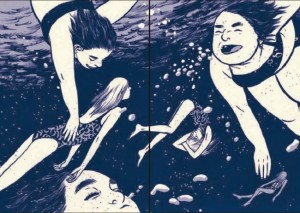 The book opens with Rose and her family returning to Awago Beach. They have a cottage, which reminds Rose’s mom of the cottage she had with her parents, and they’ve been summering at Awago Beach “ever since… like, forever.” Once dumping her things in her room, Rose rushes to say hi to her friend Windy who summers there with her mom and grandmother. The difference between Rose and Windy are obvious. Their bodies are different, and their age difference gradually gets more and more in the way. That said, as the story weaves its tale, the girls work at easing their subtle differences as they stumble through the kinks and pangs of growing up — and possibly growing apart — each in her own manner.
The book opens with Rose and her family returning to Awago Beach. They have a cottage, which reminds Rose’s mom of the cottage she had with her parents, and they’ve been summering at Awago Beach “ever since… like, forever.” Once dumping her things in her room, Rose rushes to say hi to her friend Windy who summers there with her mom and grandmother. The difference between Rose and Windy are obvious. Their bodies are different, and their age difference gradually gets more and more in the way. That said, as the story weaves its tale, the girls work at easing their subtle differences as they stumble through the kinks and pangs of growing up — and possibly growing apart — each in her own manner.
We also notice towards the beginning that while Rose’s dad makes jokes about Awago and just about everything, her mom Alice is reserved and focuses on disciplining those around her, whether about biting nails, name calling, or even appropriate table talk. We also see through flashbacks that she wasn’t always like this. Rose notices the growing tension between her parents and tries to deal with her mother’s depression and its affect on those around her. We slowly learn that Alice’s depression is connected to infertility. Through stunning, heartbreaking flashbacks we learn that the year before, Alice had a miscarriage. This is drawn and told subtly as Alice miscarries while swimming in the lake. This subtlety and silent suffering makes her pain that much more acute, and Alice’s inability to talk about it or move on makes it that more painful for all.
The third subplot revolves around the local teens who hang out at the village’s only store, Brewster’s. Dunc (whom Windy calls “The Dud”) and his friend work behind the counter and their girlfriends often come to visit. At one point, Dunc’s friend calls them sluts. Windy and Rose overhear this and call them sluts as well, without even knowing the girls or the details. The teen girls taunt Windy and Rose while talking about sex, and we soon find out that Jenny, Dunc’s girlfriend is pregnant. While she wants Dunc to acknowledge his role and come with her to the doctor, Dunc refuses. As Rose and Windy observe what’s unfolding, Rose is drawn to the drama but Windy is not. Readers are led to assume that Rose may be harboring a crush on Dunc that affects her responses.
These three plotlines converge at the end of the book as Alice plunges into the depths of the lake to save a slowly sinking Jenny, who in desperation drank too much and swam too far to safely return. After getting back to shore, Alice and Windy’s mom, thinking their girls are asleep, recount Alice’s miscarriage. Here again we experience brilliant juxtaposition as Alice, after losing her baby in the womb-like depths of the lake, saves another.
DISCUSSION SUGGESTIONS
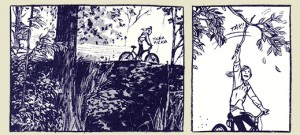 Plot, Theme, and Character Development
Plot, Theme, and Character Development
- Plot and or discuss how Windy and Rose are both growing together and growing apart. Have students compare how they react to the horror movies, to the teens outside of Brewster’s, and even to what they want to do each day and how they play.
- Create a Venn diagram representing how Windy and Rose’s personalities, likes, and dislikes overlap. Discuss the similarities and differences between the two while discussing what makes theirs such a solid friendship.
- Plot and chart each of the subplot stories. Evaluate what is told through prose and what is revealed through images in each of the subplots.
- Analyze how Alice depression is depicted in the novel. Have students brainstorm how Rose might deal with it.
- Compare and contrast how Rose, Windy, Jenny, and Dunc each deal with issues of teen pregnancy. Discuss real-life options kids have under these circumstances.
Critical Reading and Making Inferences
- Discuss the Tamakis’ use of nature as metaphor. For example:
- pp. 32-34: the depiction of milkweed pods as both magic and toxic;
- the role the lake’s depth play throughout the story
- Rose’s collection of stones, mentioned and discussed throughout the book.
- Discuss the parents’ roles in this story. Would you consider them good parents? Loving parents? Why or why not? Have students cite evidence from the story for their conclusions.
- Discuss the role Brewster’s convenience story plays in this story. Discuss the role the lake plays in this story.
- Examples of inference to discuss:
- On page 204, Rose says, “I think it’s stupid that girls can’t like. Take care of their stuff and then everything is fucked up. Maybe she deserves it?” Discuss the ramifications of what she says and what she means.
- On page 218, we see Rose looking (undiscovered) at Jenny, upset that a kid on her Huron tour asked a question about birth control and being comforted by another boy. On page 248, Rose revisits that image of Jenny being comforted, but this time the boy is intimately kissing her. Why is this drawn differently? What is going through in Rose’s mind?
- On page 252, after trying to tell Dunc she thinks Jenny may be cheating on him, Rose walks behind Brewster’s and in the dust on an old arcade game screen, Rose writes, “I think she is cheat…” and isn’t able to finish. What was she writing and why?
- On page 268, Windy asks Rose what her parents are fighting about, and Rose says “Babies… Or Nothing….” How can people fight about nothing?
- At the end of the book, Alice discusses her pregnancy and miscarriage with Windy’s mom, not realizing Rose is still awake (and listening) in the other room. Windy’s mom responds, “But Alice. You should tell her. Kids are… they get it.” Alice responds, “I know.” Discuss why Alice hasn’t yet told Rose, and debate whether she will in the near future or not.
Language, Literature and Language Usage
- Search, find, and discuss the Tamakis’ use of metaphor throughout the book.
- Discuss and explain Mariko Tamaki’s use of idiom, imagery, and humor. For example:
- On page 9: While driving towards Awago Beach they pass Estelles’ Turkey hatchery and dad says. “Hyuk hyuk! Lookiee here. I say, it’s tha Turkey Hatchery! Official birthplace of one Rose Abigail Wallace! Brings a tear to my eye.”
- On page 12: Evan, Rose’s dad says, “Awago is a place where beer grows on trees and everyone can sleep until eleven.”
- On pages 94-96: Evan holds up an eaten cob of corn and asks “Do you know that they call this here… Awago toilet paper.” Discuss they imagery and why Evan may have said this.
- On page 169: “When my mom is mad at my dad, because my dad won’t do something, or forgets to do something, she says, ‘You can say what you want, Evan, but I’m not holding my breath.’”
- On page 300: “Yes. Well. Mother Nature isn’t always the nicest person in the world…”
- Discuss the use of the word “slut” in this story and the ramifications the term carries. Discuss whether Jenny deserves to be called a slut. Discuss if there are terms to use for promiscuous boys. Why or why not?
Cultural Diversity, Civic Responsibilities, and Social Issues
- This story takes place at Awago Beach, somewhere in Canada that has a Huron Village. Research and discuss the Hurons and their culture. Look at maps and posit what small beach villages were once located in Huron territory.
- Discuss options and responsibilities associated with teen pregnancies.
Modes of Storytelling and Visual Literacy
- Compare and contrast the Tamakis’ use of visual and verbal metaphor and foreshadowing.
- Chart, evaluate, and discuss the use of visual symbolism. For example:
- the spread with the milkweed pods;
- repeated images of Rose and her family walking, showing only their feet;
- repeated images of Rose and Windy in the lake.
- While the art in this series is in blue monochrome, it has a rich, engaging feel to it. Discuss Jillian Tamaki’s use of texture and detail.
- Chart and compare the textured images versus the simpler ones. Is there a pattern to their use? Discuss how he changes the textures and details not only to emphasize particular points, but also keep the reader engaged.
- Throughout the book, there are two-page wordless spreads (for example pages 20-21, 44-45, 46-47, 47-48, 70-71, 82-83,106-107, 138-139,160-161,182-183,198-199, 222-223, 226-230, 244-245, and 292-293). Discuss their purpose. Discuss the meaning and the emotions they convey. Discuss the Tamakis’ choice to use these spreads when and where they do.
- On page 27, Windy plays with her gummy feet (over six panels). What can you tell about her from these panels?
- On page 97, Evan comes over to Alice and kisses the side of her cheek as she’s just washing a bowl. The bowl slips from her hand and shatters. What does this sequence of panels convey?
- I Kill Giants by Joe Kelly and JM Ken Niimura: About an 11-year-old girl who struggles to face and understand an untimely loss, first through escapism and then gradually through acceptance.
- Chiggers by Hope Larson: About growing up, friendships, funs and foils of summer camp.
- Are You There God? It’s Me, Margaret by Judy Blume: About the trials and tribulations of growing up, particularly for adolescent girls.
- Chinese Born American by Gene Luen Yang: Another Caldecott Honor winner about a teenager’s need to fit in.
- Before You Go by James Preller: About Jude, who takes a summer job flipping burgers at Jones Beach while dealing with his mother who is kept in a darkened room ever since his little sister drowned several years before.
- The Color of Earth Trilogy by Kim Dong Hwa: Like This One Summer, the Color of Earth Trilogy is a beautifully balanced blend of prose, poetry, and art that tactfully and sensitively deals with a girl’s growth from adolescence to adulthood.
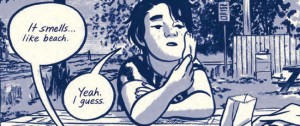 Common Core State Standards Common Core State Standards (CCSS)
Common Core State Standards Common Core State Standards (CCSS)
While it won a Caldecott honor, This One Summer is intended for readers age 12 and up. It deals with some mature themes, but it can be incorporated into language arts and content-area classes for a variety of grades. In discussing how this book meets CCSS, I will be using the Common Core Anchor Standards for College and Career Readiness for Reading, Writing, and Speaking and Listening to help guide interested educators:
- Knowledge of Language: Apply knowledge of language to understand how language functions in different contexts, to make effective choices for meaning or style, to comprehend more fully when reading or listening.
- Vocabulary Acquisition and Use: Determine or clarify the meaning of unknown and multiple-meaning words and phrases by using context clues, analyzing meaningful word parts, and consulting general and specialized reference materials; demonstrate understanding of figurative language, word relationships, and nuances in word meaning; acquire and use accurately a range of general academic and domain-specific words and phrases sufficient for reading, writing, speaking and listening at the college and career readiness level.
- Key ideas and details: Reading closely to determine what the texts says explicitly and making logical inferences from it; citing specific textual evidence when writing or speaking to support conclusions drawn from the text; determining central ideas or themes and analyzing their development; summarizing the key supporting details and ideas; analyzing how and why individuals, events, or ideas develop and interact over the course of the text.
- Craft and structure: Interpreting words and phrases as they are used in a text, including determining technical, connotative, and figurative meanings and analyzing how specific word choices shape meaning or tone; analyzing the structure of texts, including how specific sentences, paragraphs and larger portions of the text relate to each other and the whole; Assessing how point of view or purpose shapes the content and style of a text.
- Integration of knowledge and ideas: Integrate and evaluate content presented in diverse media and formats, including visually…as well as in words; delineate and evaluate the argument and specific claims in a text, including the validity of the reasoning as well as the relevance and sufficiency of the evidence; analyze how two or more texts address similar themes or topics in order to build knowledge or to compare the approaches the authors take
- Range of reading and level of text complexity: Read and comprehend complex literary and informational texts independently and proficiently
- Research to Build and Present Knowledge: Conduct short as well as more sustained research projects based of focused questions, demonstrating understanding of the subject under investigation; gather relevant information from multiple print and digital sources, assess the credibility and accuracy of teach source, and integrate the information while avoiding plagiarism; draw evidence from literary or informational texts to support analysis, reflection, and research.
- Comprehension and collaboration: Prepare for and participate effectively in a range of conversations and collaborations with diverse partners, building on others’ ideas and expressing their own clearly and persuasively; integrate and evaluate information presented in diverse media and formats, including visually, quantitatively and orally; evaluate a speaker’s point of view, reasoning, and use of evidence and rhetoric.
- Presentation of knowledge and ideas: Present information, findings, and supporting evidence such that listeners can follow the line of reasoning and the organization; adapt speech to a variety of contexts and communicative tasks, demonstrating command of formal English when indicated or appropriate.
Links and Resources:
- Preview This One Summer here: http://us.macmillan.com/thisonesummer/jilliantamaki
- stayteen.org: Information for teens on teen pregnancy, birth control, building relationships, the low down on sexually transmitted infections, myths and more.
- Teen pregnancy prevention tips and resources: http://www.cdc.gov/teenpregnancy/
- For information about teen depression:
- A site meant and written for teens on depression, discussing why people get depressed, how to cope with and fight depression and more: http://kidshealth.org/teen/your_mind/mental_health/depression.html
- On what teen depression feels like, how to talk to friends and parents, and more: http://www.helpguide.org/articles/depression/teenagers-guide-to-depression.htm
- For information about parental depression, please visit
- http://www.childtrends.org/?indicators=parental-depression
- From the Centre for Addiction and Mental Health, Canada, a site that discusses “When a parent is depressed…. What kids want to know”: http://www.camh.ca/en/hospital/health_information/for_children_youth/Pages/when_parent_depressed.aspx
- Six Things Every Kid should Know About a Parent’s Depression from PBS: http://www.pbs.org/thisemotionallife/blogs/6-things-every-kid-should-know-about-parents-depression
Meryl Jaffe, PhD teaches visual literacy and critical reading at Johns Hopkins University Center for Talented Youth Online Division and is the author of Raising a Reader! and Using Content-Area Graphic Texts for Learning. She used to encourage the “classics” to the exclusion comics, but with her kids’ intervention, Meryl has become an avid graphic novel fan. She now incorporates them in her work, believing that the educational process must reflect the imagination and intellectual flexibility it hopes to nurture. In this monthly feature, Meryl and CBLDF hope to empower educators and encourage an ongoing dialogue promoting kids’ right to read while utilizing the rich educational opportunities graphic novels have to offer. Please continue the dialogue with your own comments, teaching, reading, or discussion ideas and please visit Dr. Jaffe at http://www.departingthe text.blogspot.com.
Help support CBLDF’s important First Amendment work in 2015 by visiting the Rewards Zone, making a donation, or becoming a member of CBLDF!
All images (c) Jillian Tamaki and Mariko Tamaki.
